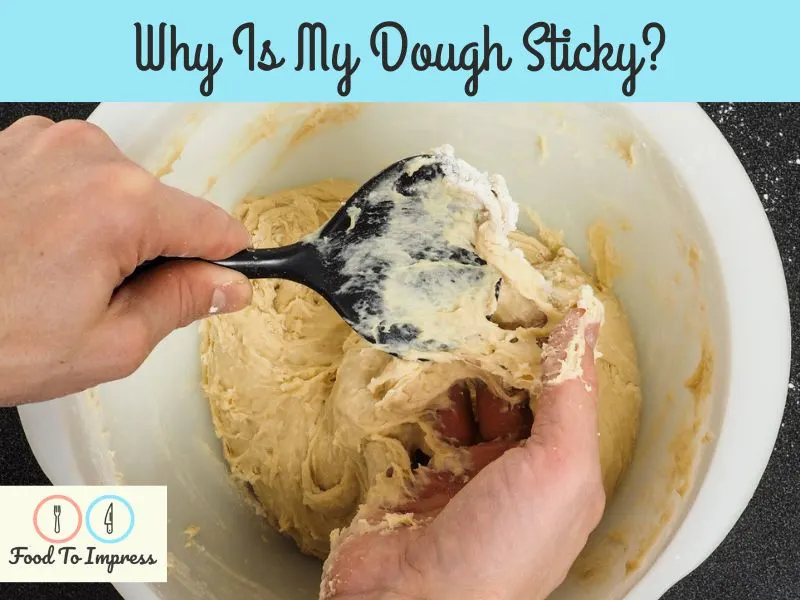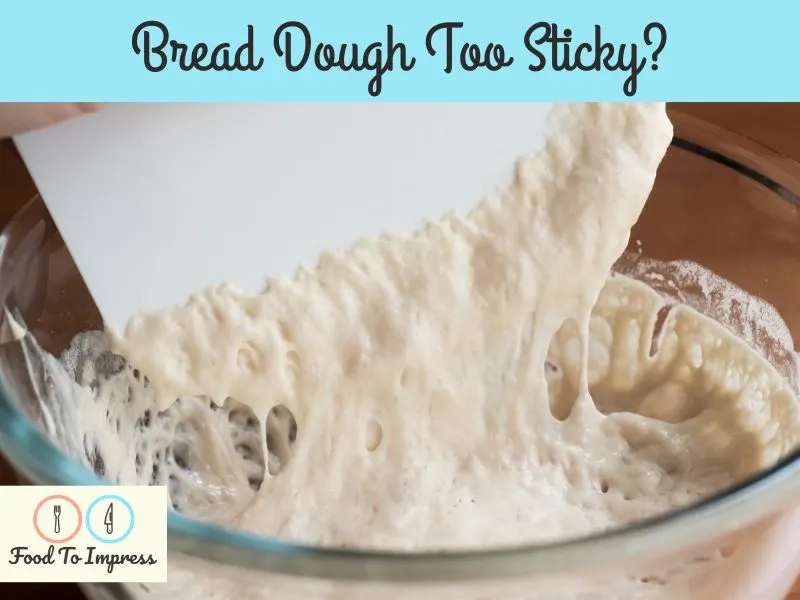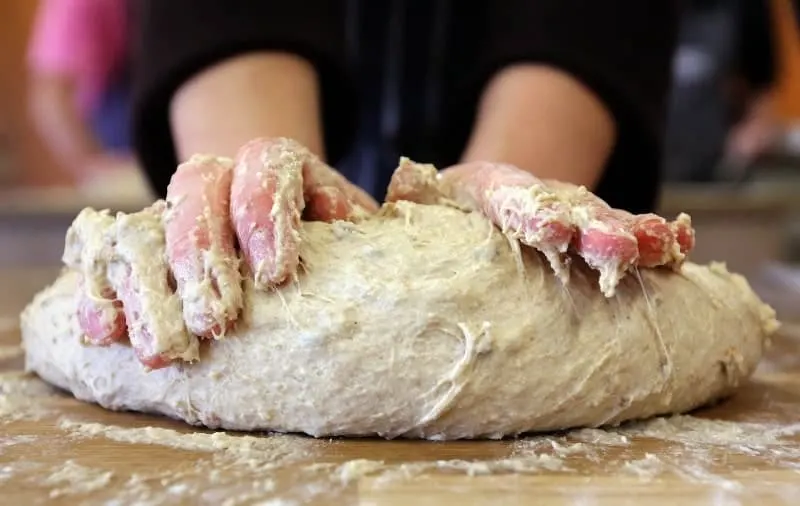As a beginner, you may be wondering why is my dough sticky? Working with bread dough can be really tricky and it’s easy to just add more and more flour until it’s no longer sticky and you’ve ruined your dough. As you get to be more experienced, handling your bread dough becomes considerably easier since you learn what you can do to help yourself work with the sticky ball of flour and water.
When you’re inexperienced with handling bread dough, it’s best to start off by making bread with lower hydration. Keeping the hydration level somewhere around 60-65% when first making dough is relatively easy for an amateur. This will help prevent sticky bread dough.
Always remember that although sticky bread dough may be a pain to deal with, it can turn out to be a great loaf of bread. Generally speaking, higher hydration bread dough has a much more open crumb with plenty of bubbles. So, if you’re interested in making tasty bread with a lovely crumb, you’re going to want to learn how to handle sticky bread dough.

Why Is My Dough Sticky?
All dough is sticky to a point. Some dough is just tacky whilst others will cling onto your hands like glue. Sticky dough isn’t necessarily a bad thing since it often produces bread with plenty of flavors and a great crumb. You just need to learn how to handle bread dough.
Beginners often make the mistake of adding more flour to their dough if it’s even the slightest bit sticky, but that’s something you should never do. If you’re kneading dough and it’s not the slightest bit tacky, you’ve most likely added too much flour.
High water content and a lack of gluten development both contribute towards a sticky dough. When handling high hydration dough, it will stick to everything and likely cause a mess. After you’ve kneaded it and developed plenty of gluten, the dough will become less sticky and easier to handle.
Dealing with sticky dough can be a difficult and messy problem, but it doesn’t have to be. If you can learn the techniques and correct ways to work with sticky dough, you’ll get to the point where you barely struggle with it at all when you are baking bread.

Bread Dough Too Sticky? How To Handle Sticky Dough
Sticky dough can be difficult to handle, but it doesn’t have to be. As a beginner, you’re not going to have enough experience with dough to know how to manage wet and sticky dough, but you’ll pick it up over time.
When it comes to handling dough properly, you can’t just expect to be able to maneuver and transport the dough with your hands alone. The dough will stick to your dry hands indefinitely if you’re not careful. What you need to do is understand how the below tips can help you to handle your dough and prevent a sticky mess.
- Start With Low Hydration
Inexperienced bakers shouldn’t be going out of their comfort zone too much. If you’re jumping straight into high hydration doughs, you’re going to struggle to knead and shape it properly.
The best thing you can do is start off with a dough that has a water content around 60-65% so it’s very easy to manage. If you haven’t made many low hydration bread recipes and you’re jumping into a high hydration recipe, you’re going to need to slow down and get some practice with more basic bread first.
With low hydration dough, it’s relatively easy to knead and shape without any struggle, so once you’ve got comfortable with this, you’ll be able to gradually increase the water content and become comfortable with a more wet dough too. - Some Extra Flour Can Help
Adding a little bit of flour to your work surface if your dough seems too sticky can be great for preventing problems during shaping and when you’re moving the dough, but plenty of beginners make the mistake of adding flour purely because it’s sticky when they’re kneading it.
I always recommend avoiding adding flour when you knead your dough unless you haven’t added enough in the first place. If you’re adding more flour during the kneading process because it’s sticky, you’re drying your dough out even more and it’s likely to ruin how it turns out. And it may ruin the dough hydration level.
You want your dough to be at least a little sticky when you’re kneading it. As you knead it and develop more gluten, it’s going to become less sticky and more easily pull away from your work surface, so there’s no need to add flour at this stage. - Get Yourself Two Dough Scrapers
There are two kinds of dough scrapers that can be great tools for helping you handle the dough better. Getting both a flexible plastic scraper and a flat metal scraper will help you in different situations. When you find the right dough scrapers, this will also help you avoid stickier dough.
They can both be used for shaping and cutting the dough, but they still have their differences. A plastic scraper is often used to mix the dough in the bowl, scrape the bowl down, and take the dough out of the bowl. The flat metal scraper is used more for moving the dough, scraping down the work surface, and cutting the dough in half. Both can be used for this though.
Either dough scraper can be used on the dough during the kneading, cleaning, and shaping process, so it’s down the personal preference. You can find dough scrapers on Amazon or in kitchen supply stores.
I personally think that a plastic scraper is great during the initial process but I like to use a metal scraper to shape and transport my dough since it’s larger and not flexible. - Use The Right Technique
The more you bake, the more you learn, and the more experience you get. With experience, you get a better understanding of how to work with dough and manage it even with the dough sticking.Over time, you’ll pick up your own technique for handling the dough or you’ll learn how to manage it by watching people with more experience in the bread making process.
For example, there are certain kneading techniques that are best for wet or sticky dough. The Rubaud method or slap and fold are both great ways to knead higher hydration dough.
Having a technique for your kneading and shaping shows a huge difference in your overall bread-making skill compared to if you didn’t have a technique. You’ll understand how to knead the dough properly, how to create surface tension, and how to handle it better overall before you bake your bread dough.In addition, by practicing, you will be able to advice to a bread recipe that includes higher hydration doughs. - Oil Your Dough
Adding some oil to your dough when you’re kneading it or when you put it in a bowl can make it much less sticky.
If you struggle to knead your dough on your surface without it sticking, simply put a thin layer of oil down and start kneading on that. It will help your dough from clinging to the surface during the first few minutes of your knead and it’ll incorporate into your dough. Depending on the recipe you may want to use olive oil.
A lot of people also like to coat their bowl and dough in a thin layer of oil to prevent it from sticking to the bowl or drying out during its rise. This makes it much easier for you to pull the dough out of the bowl without having to scrape it off the sides. - Use Water To Stop The Stickiness
I personally like to use water to handle the stickiness of higher hydration dough. If I can’t touch a dough without it clinging to my hands, I’ll simply dip them in water and pick it up that way.
Using water prevents the dough from sticking to your hands, scraper, or work surface, so it’s a great thing to try if you’re struggling with sticky dough.
I find that the best use of water is when you’re kneading or handling your dough in a way to build gluten or structure.
Using water may mean that your dough gets slightly more water incorporated into it, but it barely makes a difference. Just be sure not to add too much water to your hands. It is a gentle process of trial and error.
Does Kneading Dough Make It Less Sticky?
Kneading dough is an essential step in bread-making that helps develop the gluten strands in the dough, which gives bread its structure and texture. While it is possible to over-knead the dough, which can result in a tough and dense loaf, kneading generally helps to make the dough less sticky. As the dough is worked and stretched during kneading, the gluten structure develops, which helps to bind the ingredients together and make the dough more cohesive.
The friction created during kneading can help to absorb excess moisture in the dough, which can also contribute to reducing stickiness. It is important to note that other factors, such as the recipe and the type of flour used, can also affect the stickiness of the dough.
In conclusion, dealing with sticky dough can be a frustrating experience for any home baker. However, several ways exist to address the issue and achieve the perfect loaf of bread. Adjusting the recipe, types of bread flour used, and controlling the temperature and humidity of the dough, there are many techniques that can help to avoid sticky dough and achieve the desired texture and consistency.
By following the tips and tricks outlined in this article, bakers can take control of their dough and achieve beautiful, delicious results every time. Whether you are a seasoned baker or just starting out, these helpful tips can help you handle sticky dough with confidence and skill.

